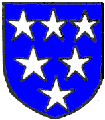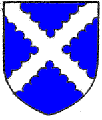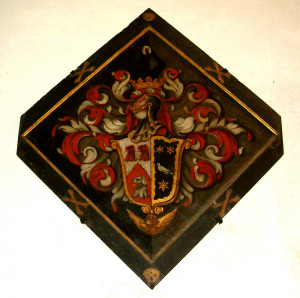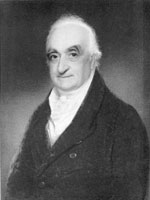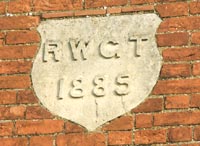As with many other places, the early manorial history of Broughton is somewhat sketchy. For the most part, one has to rely on the evidence to be found in such documents as have survived, and these do not always make it clear when land changed hands. What is certain is that the Saxon settlement of Brotone (derived from ‘broc’ and ‘tun’ meaning a settlement on a brook) was mentioned in the Domesday Book. It then consisted of two manors – one held by Walter Giffard, a loyal supporter of William the Conqueror, and the other by Countess Judith, a more shadowy figure.
Walter Giffard sub-let his land to Hugh de Bolebec whose main holding was at Whitchurch near Aylesbury, and he was the tenant at the time of the Domesday Survey. However, the de Bolebecs in their turn sub-let the estate to a family who took the name of the place, the de Broughtons. The Giffard manor then remained with this family until the end of the fourteenth century until it was acquired by the de Aylesbury family who also held nearby Milton Keynes. To complicate matters, Robert de Broughton retained a small holding in the village including that originally held by Countess Judith.
When Hugh de Aylesbury died in 1423 his land at Broughton passed to his aunt Eleanor who became the wife of Sir Humphrey Stafford of Grafton in Northamptonshire. Thus both Milton Keynes and Broughton came to be held by the Stafford family.
Meanwhile, the lands retained by the de Boughtons passed by marriage to the Howard family. Agnes Howard married William Paulet, and in 1572 they sold their holding to Thomas Duncombe. About a year later, Humphrey Stafford (the last Humphrey in the list below) also sold his interest in Broughton to Thomas Duncombe so that the manors were at last combined.
Listed below are some of the significant dates.
|
DATES
|
HOLDER
|
NOTES
|
|
1151 – 1154
|
Robert de Broughton and son William
|
mentioned as tenants in a confirmatory charter
|
|
1211
|
William de Broughton
|
probably son of the above William, mentioned in legal document
|
|
about 1245
|
Robert de Broughton
|
son of William
|
|
about 1276
|
Matthew de Broughton
|
son of Robert
|
|
about 1284
|
Ralf de Broughton
|
son of Matthew
|
|
about 1306
|
Ralf de Broughton the younger
|
probably son of Ralf
|
|
about 1316
|
Joan de Broughton
|
widow of Ralf the younger
|
|
about 1331
|
Robert de Broughton
|
(son of Ralf the younger) is mentioned in connection with Broughton but this was possibly related to the disposal of the manor to Philip Aylesbury following the death of his mother who was then married to William Passelewe of Wavendon.
|
|
1338 –
|
Philip Aylesbury
|
also held Milton KeynesSheriff of Bedfordshire and Buckinghamshire 1318, 1321, 1325 & 1330
|
|
after 1346
|
Thomas Aylesbury
|
son of Philip
|
|
– 1409
|
Sir John Aylesbury
|
grandson of Philip (died in 1409) Sheriff of Bedfordshire and Buckinghamshire 1365 & 1373
|
|
1409 – 1423
|
Hugh Aylesbury
|
son of Sir John
|
|
1423
|
Eleanor
|
sister of Sir John and wife of Sir Humphrey Stafford of Grafton (Northants)
|
|
1450-
|
Humphrey Stafford
|
son of Sir Humphrey
|
|
-1486
|
Humphrey Stafford
|
grandson of Sir Humphrey, executed for treason in 1486
|
|
1521
|
Humphrey Stafford
|
had obtained a pardon for his father in 1503
|
|
1545
|
Sir Humphrey Stafford
|
son of above
|
|
1548
|
Humphrey Stafford
|
son of Sir Humphrey, sold out to the Duncombes in 1573
|
|
in 1431
|
Thomas Nevil, Lord Latimer died .
|
he held the Manors of Crawley and Broughton
|
|
in 1455
|
Sir Thomas Lovell died
|
at that time the Manor was known as Broughton-Lovell
|
|
1460-1481
|
John de Broughton
|
it was recorded that John de Broughton presented to the church Sheriff of Bedfordshire and Buckinghamshire 1460 & 1464
|
|
in 1505
|
Sir Robert Broughton
|
bequeathed the Manor of Broughton to his brother Edward, for life
|
|
in 1529
|
John Broughton Note Green text denotes second manor
|
died leaving two daughters, Anne and Catherine. The first was married to William Lord Howard of Roworth and had a daughter, Agnes, who became the wife of William Pawlett, Lord St. John, son and heir apparent to the Most Honourable John Lord Marquess of Winchester. His Lordship, and the Lady Agnes, conveyed the Manors of Broughton and Wolston Parva to Thomas Duncombe Esq. in January 1572
|
|
1573 – 1596
|
Thomas Duncombe
|
died at Great Brickhill
|
|
1596 – 1622
|
Francis Duncombe
|
(second son of Thomas) married Mary, daughter of Thomas Porter of CoventrySheriff of Buckinghamshire 1618
|
|
1622 – 1632
|
Thomas Duncombe
|
(son of Francis and Mary) married Sarah, daughter of Thomas Draper of Islington
|
|
1632 – 1672
|
Thomas Duncombe
|
(son of Thomas and Sarah) who in 1632 appears to be only fourteen and the eldest of six children. The Ward was in the King’s hands by reason of minority.Sheriff of Buckinghamshire 1664
|
|
1672 – 1720
|
Francis Duncombe
|
|
|
1720 – 1746
|
Francis Duncombe
|
died unmarried on 14th March and is buried in the church. He left his estate to his nephew John Robinson and two nieces Frances and Susan who sold out almost immediately to Barnaby Backwell, a banker from London.
|
|
1748 – 1754
|
Barnaby Backwell
|
also held Tyringham
|
|
1754 – 1775
|
Tyringham Backwell
|
son of Barnaby
|
|
1775 – 1833
|
Elizabeth Praed nee Backwell d.1811
|
|
|
1833- 1837
|
James Backwell Praed
|
|
|
1837 – 1870
|
William Backwell Praed
|
|
|
1870 – 1909
|
Roger William Giffard Tyringham
|
|
|
1909 – 1921
|
Lieut-Col Arthur William Hervey Good
|
lived at the present Manor House at Broughton
|
|
1921 – 1960
|
Mrs Grace Marianne Good J.P.
|
widow of Lieut-Col Good. By the Second World War, Ronald Adams of Manor Farm was the principal landowner.
|

